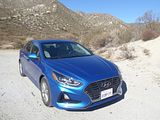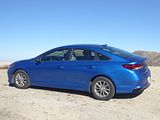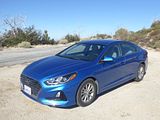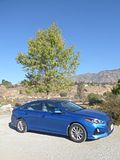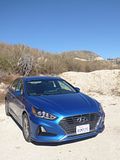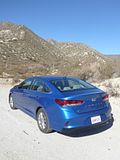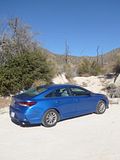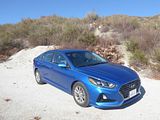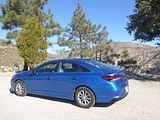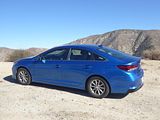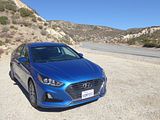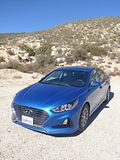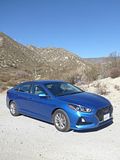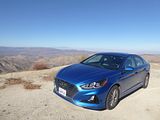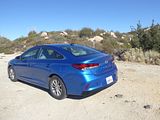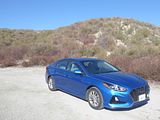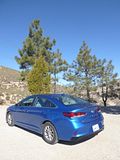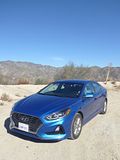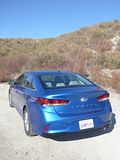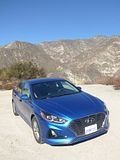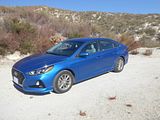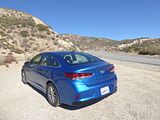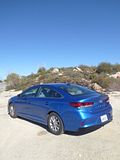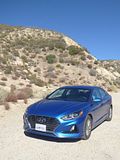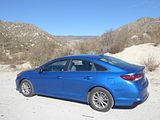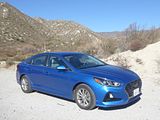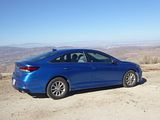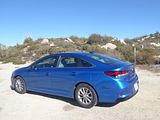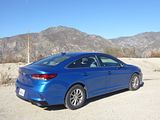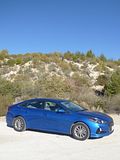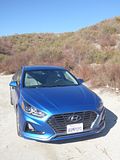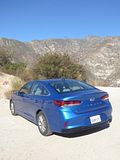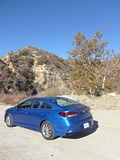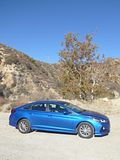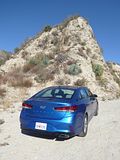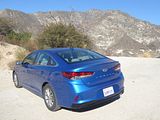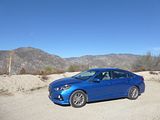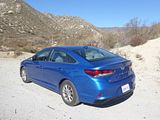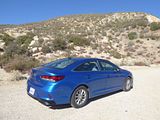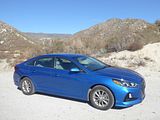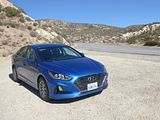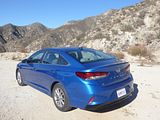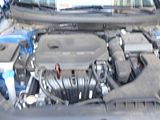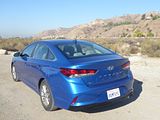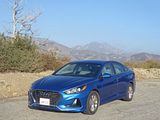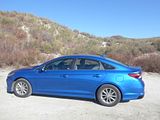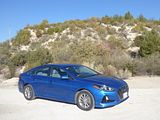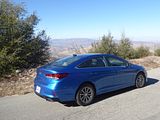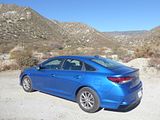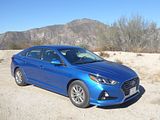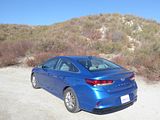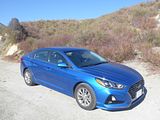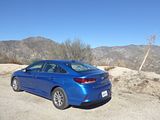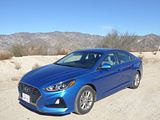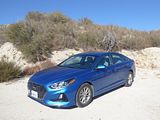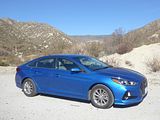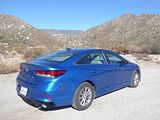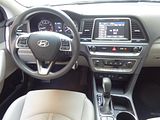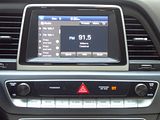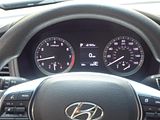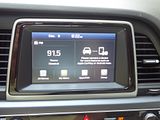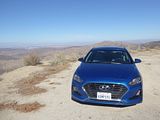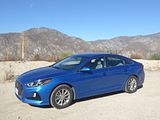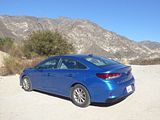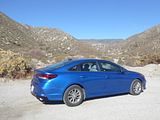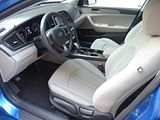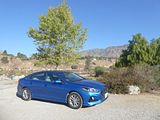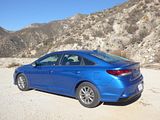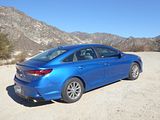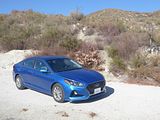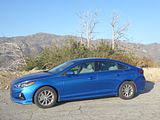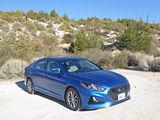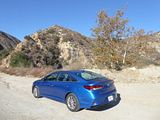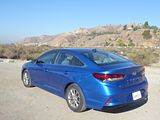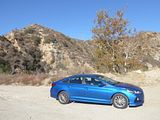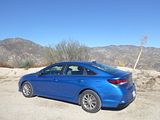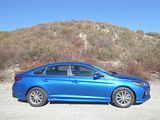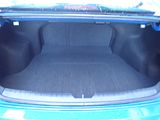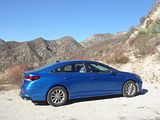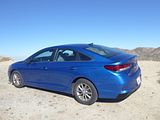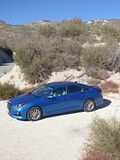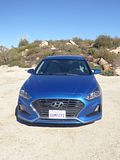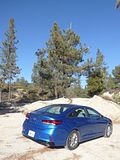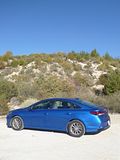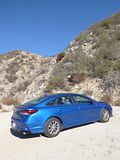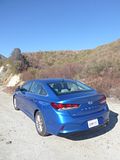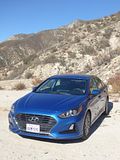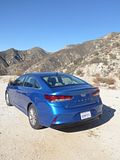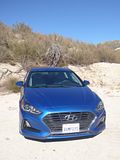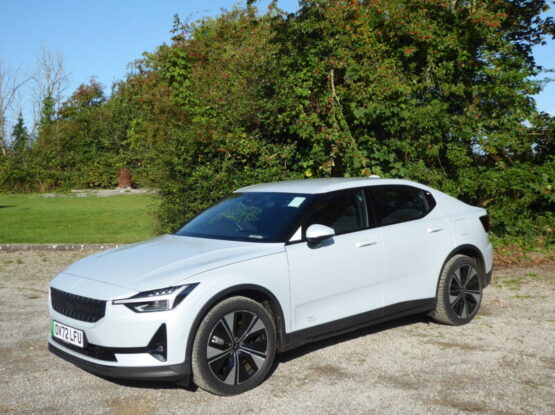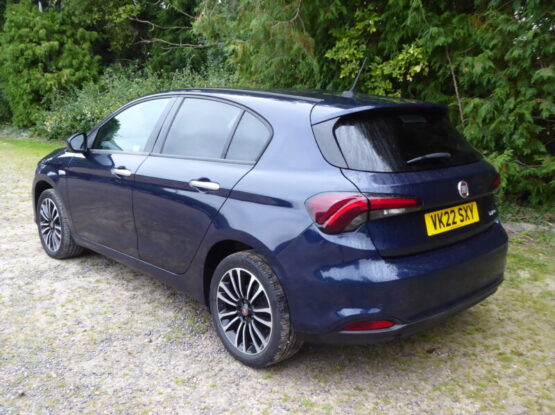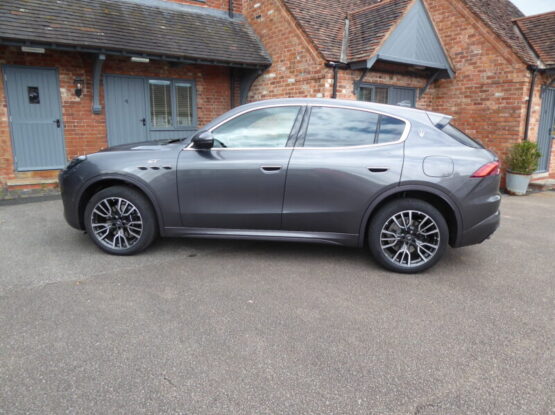Those in the UK with long memories may remember the Hyundai Sonata. After a short-lived car with this name was sold in its native Korea in 1985 and 1986, simply as a more luxurious version of the mid-sized Stellar, Hyundai started to get more serious about their expansion plans and a move upmarket from producing small family cars with the Y2 generation Sonata that made its global debut in 1988. Imports to the UK started in 1989, as Hyundai expanded their model range to three cars, but despite its Giugiaro styling (not one of his more imaginative designs it must be admitted), the car struggled in a market that thought large cars should bear badges like Ford, Vauxhall and Rover, even though the Sonata undercut these cars massively on price. Periodically, Hyundai has tried again with later generations of the car, but it has never achieved more than a handful of UK sales. In America, though, things have been very different, with successive generations of what is now called a full-sized car selling ever more strongly. Hyundai still operates shorter model cycles than most so by 2014, the seventh generation of car made its debut. Known internally as the LF series, the 2015 Sonata was a well-thought through evolution of what had gone before. While the previous YF series model had been visually quite adventurous in its styling and had sold successfully within the US, sales in Korea had failed to meet expectations so a more conservative approach was taken with the seventh generation car, to appease the Korean market, resulting in Fluidic Sculpture 2.0. The LF series car inherits many styling features from Hyundai’s Hyundai HCD-14 Concept unveiled at the 2013 New York International Auto Show. The car also takes interior and exterior styling based on the 2014 Hyundai Aslan. Under the skin it was more a case of refining what was already there and proven, with the addition of the latest technology, an ever-increasing array of safety features and generally more standard equipment. I got my chance to sample the LF series with a test in April 2016 of an entry level SE spec car and then a year later was able to try the Hybrid version. Both of them impressed me, but Hyundai is not a marque to stay still for long, so despite the fact that the cars were only a couple of years old, a facelifted seventh-generation Sonata was unveiled on March 8, 2017, for which the Korean name was ‘Sonata New Rise’. The exterior received a radical redesign more in line with the sixth-generation, including new headlights, tail lights, cascading grille, and optional vertical LED lighting. The front of the 2018 Sonata shares some characteristics of the sixth generation Grandeur/Azera. The dashboard was reshaped, with new air vents on the driver’s side and a larger touch screen that is compatible with Apple CarPlay and Android Auto. The interior also received a new steering wheel, gearshift, and instrument cluster. A number of other standard features were added in the refresh and the trim levels were shuffled, with a mid spec SEL car being introduced which led to some features that had been previously offered across the whole range being removed from the base SE and Eco trims. Given the Sonata’s continued success in the US market, it was a car that I was keen to test.
Almost all the Hyundai models disappeared from Hertz’ US fleet during 2018 and 2019, because prior to that there had been so many of them that customers had apparently been complaining quite bitterly that they only ever got a Hyundai. If true, that seemed a bit disingenuous, as this Korean brand has been producing some of the best cars in each class in which they compete for some time now, and it simply meant less ultimate choice for the car renter as the numbers were made up of other models that were already on fleet. Things started to change in late 2019, I noticed, with Hyundai cars reappearing. The car fleets of 2021 are a mix of cars that were relatively new just before the Covid lockdowns and then in the supply constrained times that have ensured more recently, whatever the car rental firms could source either as brand new orders or from the second hand market. The Sonata I found and took to test for a day was a 2019 model year car, and it had covered 33,600 miles, but some of the paperwork in the glovebox, suggested that Hertz was not its first owner. Be that as it may, at least I could get the chance to renew my acquaintance with the seventh generation Sonata but in its facelifted guise.
The engine in the test car was the 2.4 litre four cylinder Theta unit which has been used in a number of Hyundai models for some time now. It puts out 185 bhp and 178 lb/ft of torque which is bang on class average. A more economical 1.6 Turbo four and a more powerful 2.0T four are available in specific other models in the range. The engine is certainly very smooth and it generally comes across as quite eager and willing, though there were occasions when I found it needed to be worked quite hard, especially when going up hills, to get what I expected from it. Part of the reason for this could be the gearing in the six speed auto box, as I found it had a tendency to go quite readily to the upper gears when there times that this was not appropriate. That apart, the Sonata is a refined car and noise levels at steady speed on the freeway are pleasingly low. I covered 158 miles during my day with the Sonata and it needed 5.25 gallons to fill it up again, which computes to 30.09 mpg US or 35.96 mpg Imperial, not perhaps quite as good as I was expecting, but it is quite possible that I returned the car rather more full than it was on collection, as is often the case with rental vehicles.
I thought this one of the better cars in the class to drive, thanks largely to the fact that the steering is well weighted and has some decent feel to it. Whilst not quite in the Ford Fusion and Mazda 6 category, this plus the overall handling characteristics made it surprisingly good when up on the canyon roads north of Los Angeles. Body roll is kept well in check. There is no penalty in terms of ride, with the combination of the 205/55 R16 wheels and fairly soft suspension meaning that the Sonata was comfortable even on some of the terrible road surfaces that afflict the LA area. There were no concerns with the brakes which did their job well, with the pedal proving pleasingly resistant to fade even when getting a reasonably hard time on some of those canyon roads. There is a foot operated parking brake in lower spec Sonata models, but with an auto gearbox this is largely redundant anyway. Visibility is good, with an ample field of vision through the windows and from the mirrors, aided by the blind spot warning system. The rear-view camera certainly helps.
The interior design of the Sonata has definite overtones of Audi, and that is no bad thing. For a mass-market car, this feels like a quality product, with a neat and integrated design and the use of good quality materials even in this entry level SE trim. The Koreans are still not afraid to use light colours on the dash and door casings, and this car had the lower surfaces in beige, which certainly made the cabin feel less gloomy than you get in some rival products. The selection of colours and textures including mottle gunmetal-effect inlays is good and everything gives the impression it will stay that way for some time. There is a neat and simple instrument cluster with two large dials for the speedometer and rev counter with smaller fuel level and water temperature gauges inset. Two column stalks feature, with the lights operated from the left hand one. There is an auto function for these. There are a lot of buttons on the steering wheel boss, for cruise control, audio repeater and trip computer display selection. The centre of the dash contains what by current standards is a fairly simple 7” colour touch screen for the infotainment. There are an array of buttons underneath it which means that it is easy top operate. In SE spec you don’t get XM Satellite radio or navigation but there is Apple Car Play and Android Auto, as well as Blueooth. There are six speakers and sound quality seemed pretty decent for such a system. Beneath this unit are the controls for the air conditioning which is of the manual sort and not the fully automated climate control you get in higher trim versions.
As you might expect in an entry level car, there is all-manual adjustment for the front seats, but these extend over quite a wide range, so everyone should be able to get the position they want. The steering wheel telescopes in/out as well as up and down and there are height adjustable seat belts. I found the seat to be very comfortable though I did not actually have a really long journey to put it to the ultimate test.
Although not quite as spacious as the rival Honda Accord and Toyota Camry, there is plenty of space in the back, with sufficient leg room for even the tall with the front seats set well back, and headroom should not be a problem, either. Whilst there is minimal intrusion from any sort of central tunnel, the central console does extend quite far back, so a middle seat occupant may feel a little challenged for knee room. Even on the entry level SE spec, you get a drop-down central armrest which features cupholders on its upper face and there is one seat-back map pocket as well as door bins for odds and ends.
The boot is a good size, one of the largest in its class, and is easy to load. There are asymmetrically split folding rear seat backrests which will endow the Sonata with a much longer load platform. There is a space saver tyre under the boot floor and there is some space around this for a few bits and pieces. Inside the cabin there is a good-sized glovebox, door bins, a deep armrest cubby and a well in front of the gearlever which in total is at least as good or better than you will get from other cars in this class.
After the significant upgrade made to the 2018 model year Sonata, Hyundai made no changes of note for the 2019 model year cars. These come in six trim levels: SE, Eco, SEL, Sport, Limited, and Limited 2.0T. Whilst the entry level SE model has a healthy helping of tech features, if you want more comfort and convenience add-ons, you probably need to consider the Sonata SEL. To get the strongest engine, you’ll have to get the range-topping Limited 2.0T. The base Hyundai Sonata SE comes with a 185 bhp four-cylinder engine, a 7-inch touch screen, Android Auto, Apple CarPlay, a USB port, Bluetooth, a six-speaker stereo, cloth upholstery, alloy wheels, a rearview camera, blind spot monitoring, rear cross traffic alert, and lane change assist. The Eco trim has largely the same interior equipment as the base SE, but it features a more fuel-efficient 178 bhp turbocharged four-cylinder engine. SEL models revert to the SE’s engine. This trim gains satellite radio, wireless device charging, a rear-seat USB port, Hyundai’s Blue Link telematics system, heated front seats, an eight-way power-adjustable driver’s seat, proximity keyless entry, larger alloy wheels, and a hands-free trunk lid. You might find some models with adaptive cruise control, lane keep assist, automatic emergency braking, pedestrian detection, and an electronic parking brake. Standard features in the Sport trim include a sunroof, a flat-bottom steering wheel, front sport seats, and a few styling tweaks, such as chrome accents. Sport models share the SE’s engine, and the same safety features offered in the SEL are available in this trim as well. The Sonata Limited also boasts the SE’s engine and gains an 8-inch touch screen, a navigation system, an eight-speaker Infinity stereo, leather upholstery, ventilated front seats, a six-way power-adjustable front passenger seat, an auto-dimming rearview mirror, and adaptive headlights with automatic high beams. The Limited also comes with rear parking sensors and the same optional driver assistance tech from the SEL and Sport trims. The high-end Limited 2.0T model comes with a 245 bhp turbo-four engine and just about every feature you can get in this Hyundai, including a panoramic sunroof.
Whilst you would never call the Sonata – probably even in its most potent and luxurious guise – exciting, it cannot be denied that this is a very capable car, without doubt one of the best in its class. It goes well enough, is decently economical, surprisingly good to drive even on the less than straight roads, rides well, is comfortable and roomy for four or perhaps five adults, is nicely finished and by all accounts has a good reputation for reliability. It is even available in some attractive paint finishes like the Electric Blue Metallic of the test car. So there’s a lot to like and not really much to criticise here, and that is undoubtedly why the Sonata sells so strongly in the US, not just to the rental fleets but also to retail customers. It has strong competition, of course, so selecting between the diminishing number of alternatives in the full-size sedan category may well come down to personal taste. Were I in the market for such a car, I would give it very strong consideration, and were I faced with one of these or its rivals at the rental car counter, I could easily fall for the Sonata.


